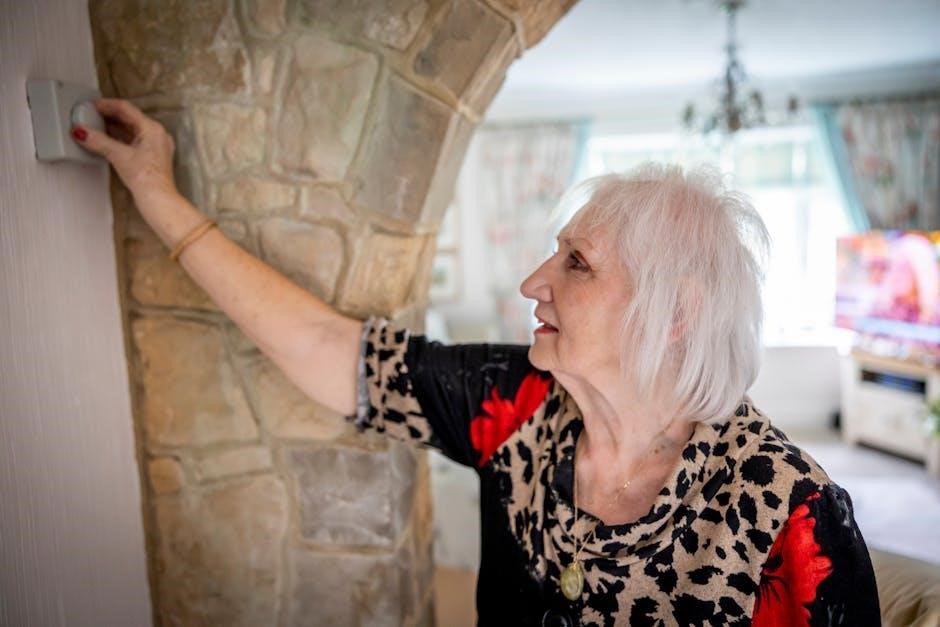British Gas RC Plus Thermostat Manual: A Comprehensive Guide
Welcome! This guide delivers comprehensive instructions for the British Gas RC Plus Thermostat. From initial setup to advanced programming and troubleshooting, this manual ensures optimal home heating control. Based on user experiences and re-badged Drayton Digistat information, we aim to provide clear, concise assistance.
The British Gas RC Plus Thermostat is a user-friendly device designed for efficient central heating control. Notably, it’s a re-badged version of the Drayton Digistat, sharing many functionalities and features. This thermostat allows homeowners to easily manage their heating schedules, ensuring comfort while optimizing energy consumption.
This thermostat offers wireless programmability, providing flexibility in controlling your home’s temperature from a convenient location. The RC Plus enables users to set different temperature programs for various times of the day and days of the week, catering to individual lifestyle needs.
The British Gas RC Plus Thermostat aims to simplify home heating management, offering a straightforward interface and reliable performance. It provides energy-saving benefits, helping reduce heating costs by accurately maintaining desired temperatures. Whether you’re new to programmable thermostats or seeking to enhance your existing system, this model offers a practical solution.
Understanding its basic features and settings is crucial for maximizing its benefits. This manual provides detailed guidance, ensuring users can confidently operate and troubleshoot their British Gas RC Plus Thermostat;
Identifying the Drayton Digistat Equivalent
The British Gas RC Plus Thermostat is essentially a rebranded version of a Drayton Digistat model. Recognizing this equivalence is crucial for accessing comprehensive manuals and troubleshooting guides. The most common equivalent is often cited as the Drayton Digistat 2 or Digistat 3, although functionality may slightly vary.
To confirm the exact Drayton Digistat model, compare the features and interface of your British Gas RC Plus with available Drayton Digistat manuals online. Look for matching button layouts, display information, and programming options. This comparison will help you pinpoint the most accurate corresponding model.
Identifying the correct Drayton Digistat equivalent unlocks a wealth of resources, including detailed user manuals, installation guides, and troubleshooting tips directly applicable to your thermostat. This knowledge is particularly helpful if you’ve misplaced your original British Gas documentation.
By understanding that the British Gas RC Plus is a re-badged Drayton Digistat, you can leverage a broader range of support materials, ensuring you can effectively manage and maintain your heating system. This approach simplifies finding solutions to common issues and optimizing your thermostat’s performance.

Accessing the Drayton Digistat Manuals Online
Once you’ve identified the Drayton Digistat model equivalent to your British Gas RC Plus thermostat, accessing the relevant manuals online is straightforward. Begin by visiting the official Drayton Controls website. Navigate to the “Support” or “Downloads” section, where you can search for manuals by model number.
Alternatively, use a search engine like Google, entering the specific Drayton Digistat model number followed by “manual PDF.” This often yields direct links to downloadable manuals. Websites like Gas Appliance Guide also host Drayton Digistat manuals, providing another valuable resource.
When downloading manuals, ensure they match your thermostat’s features and functionalities. Compare the manual’s diagrams and instructions with your device to confirm compatibility. Pay close attention to the version number or publication date to ensure you have the most accurate and up-to-date information.
These online manuals provide detailed guidance on everything from basic operations to advanced programming and troubleshooting. Having digital access ensures you can quickly reference instructions whenever needed, making it easier to manage your heating system effectively and address any issues that may arise.
Understanding Basic Operations: Turning Heating On/Off
The British Gas RC Plus thermostat, like its Drayton Digistat counterpart, offers simple controls for basic heating functions. Turning the heating on or off is typically achieved through the central dial or buttons on the thermostat’s interface. Locate the power button, often indicated by a universal power symbol, or the mode selection dial.
To turn the heating on, ensure the thermostat is set to “Heat” or “Auto” mode. The “Heat” mode provides continuous heating, while “Auto” mode follows programmed schedules. Adjust the desired temperature using the up and down arrows or the temperature dial. The display will show the set temperature.
To turn the heating off, set the thermostat to “Off” or “Frost Protection” mode. “Off” completely disables heating, while “Frost Protection” maintains a minimum temperature to prevent freezing pipes during cold weather. Check the display to confirm the heating is off and the set temperature is below the current room temperature.
Some models might have a boost function for temporary heating. Pressing the boost button activates heating for a set duration, usually 1-2 hours. Always consult your specific manual for precise instructions and available modes, ensuring optimal control and energy efficiency.
Programming the Thermostat: Setting Schedules
Programming the British Gas RC Plus thermostat allows you to customize heating schedules, optimizing comfort and energy usage. To begin, locate the “Program” or “Schedule” button on the thermostat. Pressing this button usually initiates the programming mode. The display will then prompt you to set different time periods and corresponding temperatures for each day.
Typically, you can set multiple time periods per day, such as morning, afternoon, evening, and night. Use the up and down arrows to adjust the start time and desired temperature for each period. The thermostat may offer preset schedules as a starting point, which you can then modify to fit your specific needs.
Some models allow you to set different schedules for weekdays and weekends. This feature enables you to maintain comfortable temperatures during your typical workweek while adjusting for leisure time on weekends. Once you have programmed your desired schedules, save the settings by pressing the “OK” or “Enter” button.
Remember to review your programmed schedules periodically to ensure they still align with your lifestyle. Regularly adjusting schedules can further improve energy efficiency and maintain consistent comfort levels. Consulting the Drayton Digistat manual can also provide additional guidance, as the British Gas RC Plus is often a re-badged version.
Troubleshooting Common Issues
Encountering issues with your British Gas RC Plus thermostat can be frustrating, but many problems have simple solutions. One common issue is the thermostat not responding to temperature adjustments. Ensure the batteries are fresh and properly installed. Low batteries can cause erratic behavior or complete failure. If replacing the batteries doesn’t resolve the issue, try resetting the thermostat to its factory settings.
Another frequent problem is the heating system not turning on or off as scheduled. Verify that the programmed schedule is correctly set and that the thermostat is in the correct mode (e.g., auto or manual). Check the wireless connection between the thermostat and the receiver unit, if applicable. Obstructions or interference can disrupt the signal.
If the display is blank or showing error codes, consult the Drayton Digistat manual, as the RC Plus is often a re-badged version. Error codes can provide valuable clues about the nature of the problem. Additionally, ensure that the boiler is functioning correctly and that there are no issues with the central heating system itself.
For persistent problems, consider contacting a qualified heating engineer. Attempting complex repairs without proper knowledge can be dangerous. Simple checks and resets can often resolve common issues, but professional assistance may be required for more intricate problems.
Resetting the Thermostat
Resetting your British Gas RC Plus thermostat can often resolve various operational issues, restoring it to a default state and clearing any incorrect configurations. The reset process typically involves a few simple steps, although the exact procedure may vary slightly depending on the specific model.

First, locate the reset button on the thermostat. This button is often small and may require a pointed object, such as a pen or paperclip, to press. Before initiating the reset, ensure you have noted any custom settings, such as programmed schedules, as these will be erased.
Press and hold the reset button for approximately 5-10 seconds; The thermostat display should either go blank or show a reset confirmation message. Once the reset is complete, the thermostat will usually revert to its factory default settings, requiring you to re-enter your desired configurations.
If you cannot find a dedicated reset button, try removing the batteries for a few minutes. This can sometimes achieve a similar effect, clearing the thermostat’s memory. After reinserting the batteries, the thermostat should power on in its default state;
After the reset, consult the Drayton Digistat manual (if applicable) to guide you through reprogramming your thermostat. Ensure you set the correct date, time, and heating schedule to optimize your home’s heating efficiency. A successful reset can often resolve glitches and improve overall thermostat performance.

Simple Home Fixes for Thermostat Problems
Before calling an engineer for thermostat issues, several simple home fixes can often resolve common problems with your British Gas RC Plus thermostat. These solutions can save time and money while restoring your heating system to optimal performance.
Firstly, check the batteries. Low battery power is a frequent cause of thermostat malfunction. Replace the batteries with fresh ones, ensuring they are correctly inserted. After replacing the batteries, observe if the thermostat display functions properly and responds to adjustments.
Secondly, ensure the thermostat is clean. Dust and debris can accumulate inside the unit, interfering with its sensors and buttons. Gently clean the thermostat’s exterior with a soft, dry cloth. Avoid using liquids, as they can damage the internal components.
Thirdly, verify the thermostat’s location. The thermostat should be positioned away from direct sunlight, drafts, or other heat sources, as these can affect its temperature readings. If the thermostat is improperly located, relocate it to a more suitable area.
Fourthly, check for any obstructions. Ensure that furniture or other objects are not blocking the thermostat’s airflow. Obstructions can prevent the thermostat from accurately sensing the room’s temperature.
Finally, if none of these fixes work, try resetting the thermostat as described in the reset section. Remember to reprogram your settings afterward. These simple steps can often restore your thermostat to proper working order.
Understanding Error Codes (if applicable)
The British Gas RC Plus thermostat, like many digital devices, may display error codes to indicate specific issues or malfunctions. Understanding these codes is crucial for diagnosing and resolving problems efficiently. While the RC Plus is re-badged Drayton Digistat, error codes can vary.
Common error codes might relate to communication problems between the thermostat and the receiver unit, sensor failures, or issues with the heating system itself. Consulting the Drayton Digistat manual, which serves as a reference for the RC Plus, is essential for accurate interpretation.
For instance, an error code indicating a sensor failure suggests that the thermostat cannot accurately read the room temperature. This may require professional repair or replacement of the sensor.
Another common error might signal a loss of communication between the thermostat and the boiler. This could be due to interference, a faulty receiver unit, or a problem with the wiring.
When an error code appears, note it down and refer to the relevant manual. The manual will provide a description of the error and recommended steps for troubleshooting.
In some cases, resetting the thermostat might clear the error code. However, if the error persists, it’s best to contact a qualified heating engineer for further assistance. Attempting complex repairs without proper knowledge can lead to further damage or safety hazards.
Energy Saving Tips with Your Thermostat
Optimizing your British Gas RC Plus thermostat settings is a crucial step in reducing energy consumption and lowering heating bills. Given its re-badged identity as a Drayton Digistat, understanding its programming capabilities is essential for efficient energy use.
One key strategy is to program a heating schedule that aligns with your daily routine. Set lower temperatures for periods when you are away from home or asleep. This prevents unnecessary heating of empty rooms, leading to significant energy savings.
Utilize the thermostat’s setback feature to automatically lower the temperature by a few degrees when you leave for work or during the night. Even a small reduction in temperature can make a noticeable difference in your energy consumption.
Consider investing in smart thermostatic radiator valves (TRVs) for individual room control. This allows you to heat only the rooms you are using, further optimizing energy efficiency. TRVs work in conjunction with your thermostat to maintain consistent temperatures throughout your home.
Avoid overheating your home. A comfortable temperature range is typically between 18°C and 21°C. Each degree above this range can significantly increase your energy consumption. Regularly check and adjust your thermostat settings to ensure optimal efficiency.
Finally, ensure your home is well-insulated to prevent heat loss. Proper insulation in walls, ceilings, and floors minimizes the need for excessive heating, maximizing the energy-saving potential of your thermostat.

